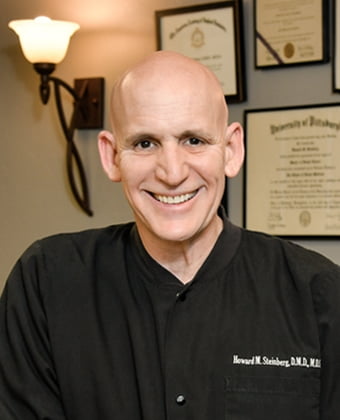Restorative Dentistry

Restoring Quality of Life
The loss or damage of even a single tooth can have a considerable impact on everyday life and self-esteem. Fortunately, Dr. Steinberg offers a variety of ways to restore or replace teeth. In fact, with today’s latest technologies and materials, individual teeth – or even entire rows of teeth – can be replaced for a natural appearance and restored function. Today’s modern dental restorations help thousands of people improve their lives. We invite you to learn more about the many options available to you, and how to make that first big step toward regaining a natural, self-assured smile.
Indirect Restorations
Indirect tooth restorations are done when extensive tooth structure has been damaged or needs to be replaced. Rather than simply filling the damaged area, indirect restorations are designed and fabricated outside the mouth. Dental crowns, bridges, implants, dentures, onlays and inlays are examples of indirect dental restorations. While the final restoration is being fabricated, a temporary restoration is often used to cover the tooth.
Direct Restorations
Direct tooth restoration involves placing small amounts of material directly into a tooth that has been compromised by decay, wear or trauma. Conventional amalgam fillings are an example of a direct dental restoration. The type of material used depends on the location and nature of the damage. For example, composite resin may be used to fill a cavity in a highly visible area. Glass ionomers are often used in areas not subject to heavy pressure.
Restorative Dental Statistics
80% of people have at least one filling
6% have no natural teeth
19% wear dentures
31% have tooth decay
Advantages of Restoring Teeth
Natural Tooth Function
Restoring teeth has been a mainstay of modern dentistry for many years. But only after the advent of dental implants and ceramics have patients been able to enjoy restorations that feel, function and look like natural teeth.
Limitless Possibilities
Modern dental restorations are supported by either the remaining natural teeth, dental implants or any combination of the two.
Biocompatible Materials
The materials used in restorative dentistry are also 100% biocompatible. Titanium is currently the most suitable implant material.Titanium dental implants are biocompatible and do not trigger any allergiC reactions. Ceramic materials used in restorative dentistry are biocompatible. All-ceramic materials do not cause any allergic reactions, and sensitivity to heat or cold are a thing of the past.
Improved Quality of Life
Restorative dentistry has helped thousands of people improve the quality of their lives. Modern dental restorations help revitilize your smile and improve your oral health. Patients that have had restorative dental procedures often live a longer, happier and healthier life.
Common Restorative Procedures
Implants
Dental implants replace lost or missing teeth with artificial analogues. Probably the most important development in dentistry, implants are used singly, to support a crown, or in groups to stabilize dentures or bridges.
Bridges
Dental bridges are used to bridge the gap created by one or more missing teeth. The bridge is cemented to adjacent teeth or affixed to dental implants. Bridges are typically made of porcelain fused to metal, or plastic supported by a metal framework.
Crowns
Dental crowns are used restore broken, misshapen or severely decayed teeth. Today’s all-porcelain crowns have an incredibly natural appearance. Dental crowns are cemented into place over a tooth or affixed to dental implants.
Dentures
Dentures consist of a plastic base that is colored to replicate gum tissue and supports a full set of prosthetic teeth. Conventional dentures are removable by the patient. Dentures can also be attached to dental implants.
Are You Ready to Restore Your Teeth?
If you have considered restorative dentistry but haven’t taken that first step, now is the time! Review the broad spectrum of restorative dental procedures available. At Dr. Howard M. Steinberg’s Tucson office, we restore, renew, and enhance smiles until they are truly works of art. You’ll never regret the decision to achieve enhanced dental function and beauty.
REQUEST A FREE CONSULTATION. Your new, healthy smile starts with a free, no obligation consultation





